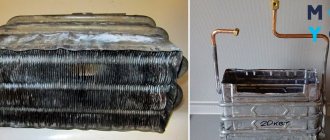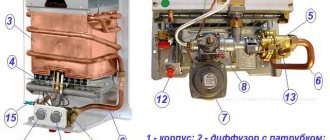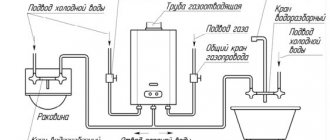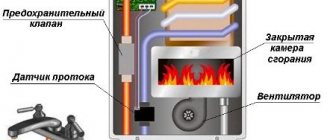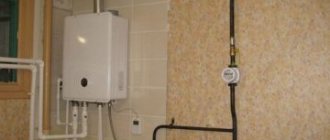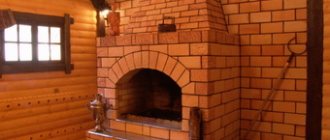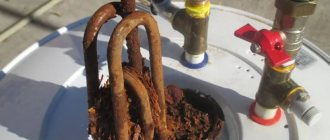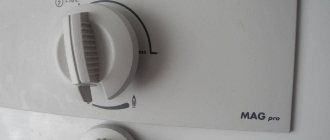Here you will learn:
- Symptoms for urgent column cleaning
- What you can do on your own
- How to remove the casing of a Bosch water heater
- How to remove and clean the igniter
- How to clean and how to rinse the filter
- How to clean a geyser from scale
- How to clean a radiator
- How to remove soot from a heat exchanger
- Prevention
The reasons for contamination of a flow-through water heating device are related to its functions and operating principle:
- Flowing water supply. The column heats the water flowing through its heat exchanger, which brings with it mineral inclusions. As a result, clogging deposits settle on the walls of the heat exchanger and pipes of the device and gradually increase.
- Gas burner burning. In case of incomplete combustion of gas (see reasons below), carbon deposits and soot are formed. The latter clogs the fins of the heat exchanger and the chimney, further impairing the combustion of gas fuel and slowing down the heating of water.
- Low quality tap water. Due to the hardness of tap water, when it is heated, salts are released from the composition, which are deposited in the form of scale inside the pipes and heat exchanger. The thicker the layer of scale, the narrower the lumen of the pipe and the worse it passes water.
In addition to magnesium and calcium salts dissolved in water, it contains mechanical impurities from rusting pipes. They also participate in the gradual growth of the pipe channel in the heat exchanger together with scale.
As for soot, its active formation is facilitated by increased pressure on the burner, weak chimney draft (low height, cracks, lack of thermal insulation, etc.), lack of supply air (PVC windows are sealed, but there is no supply valve).
Soot deposition is also facilitated by the use of forced exhaust in a room with a working water heater (causes a lack of oxygen), dustiness of the room (dust enters the burner, due to which complete combustion of the gas does not occur).
Filters and magnetic traps, fine adjustment of the burner and air draft will slow down the process of column clogging, but will not completely eliminate it
Since scale formation is more intense when water is heated above 60°C, some owners of German water heaters set the burner heating temperature to low. However, as a result of this, the working cavities of the heat exchanger gradually become overgrown with a greenish coating from condensate.
As a result, the removal of flue gases deteriorates, which contributes to the accelerated formation of soot. A heat exchanger clogged with soot heats water very poorly - soot is a good heat insulator.
Symptoms for urgent column cleaning
There are several signs that should prompt the owner to think about immediately cleaning the unit:
- clap when igniting the burner (by the way, a popular “disease with the Bosch WR 10-2B according to user reviews);
- the burner turns off quickly;
- soot spills out from under the casing;
- the water barely heats up at maximum power of the device;
- there is a weak water pressure coming from the tap (although, for example, the Avangard models can work perfectly well with low water pressure).
You can fix the problems like this:
- clean the jets;
- clean the igniter;
- remove soot from the heat exchanger;
- rinse the heat exchanger of the gas water heater to remove any scale that has formed.
Each of the events held has its own characteristics. Cleaning a geyser with your own hands involves initially turning off the water and gas supply.
Cleaning the heat exchange element
This procedure is a little more complicated than the work of removing dirt from the water intake unit. All actions can be carried out in four stages:
First you need to disconnect the pipes through which water gets in and out.
Very often, the fasteners on the pipes are covered with scale. To make it easier to unscrew the nuts, you can apply WD-40 universal fluid to the joints. After a few minutes, when the scale has been neutralized, you can safely unscrew the nuts using wrenches.
After this, you need to fill the heat exchange element with descaling liquid.
Among folk remedies, a solution of citric acid performed best. Firstly, it’s safe, and secondly, it’s very inexpensive. Proportions: 1 liter of water requires 200 grams of acid.
The poured solution should be kept inside for several hours (it is better to leave it overnight).
The heat exchanger housing also needs to be cleaned. To do this, it is recommended to dilute vinegar (9%) in water (proportions 1:3). Never use hydrochloric acid. It reacts with the metal, causing the appearance of additional oxidation products.
After several hours have passed, the citric acid solution can be drained.
Important ! It is NOT necessary to install the heat exchange element immediately after this. There could still be scale products inside it and they need to be removed
To do this, the heat exchanger must be rinsed with strong water pressure!
After washing, you can install the pipes.
It was mentioned above that all work can be done independently. This is true, but you should never disassemble the gas unit of the column. It can only be cleaned.
The process of cleaning the gas part from carbon deposits is not very complicated; prepared wire is useful for this. A wire is inserted into the holes of the jets, thereby removing all dirt and soot.
When this operation is completed, it is important to check the column for possible gas leaks. The same principle applies here as when searching for a puncture on a wheel: a soap solution is applied to all joints and the absence/presence of bubbles will indicate whether there is a leak.
If you notice bubbles, you need to call the gas service and call a specialist!
Gas water heaters are found in many houses. They are practical and durable. But often their efficiency decreases, which significantly affects the quality of heated water. This occurs due to the fact that scale forms in the column
It is very important to remove it; this is the only way to restore the functionality of the equipment. You can clean the gas water heater yourself
But this must be done strictly according to the instructions. Only then will you be able to clean the gas water heater in a safe manner and avoid making mistakes during this process.
Home water heaters require regular cleaning to prevent further damage.
What you can do on your own
Before starting work, turn off the gas and water supply to the column. Under no circumstances attempt to repair the gas part of the device yourself! This may lead to an emergency.
At home you can clean:
- burner for soot and soot;
- internal parts from dust;
- heat exchanger – from scale;
- water pipes.
And also check:
- condition of the water intake unit;
- tightness of connections;
- serviceability of the traction sensor;
- presence of lubricant.
All operations are carried out in a certain sequence.
Performance
When choosing and purchasing a gas water heater, it is very important to pay attention to its performance. This will determine whether the equipment will be able to fully serve you. This figure can be 6-11 l/min, 12 or 14 l/min, and usually depends on the burner power, which is 11-19 kW, 22-24 kW or 28-30 kW, respectively
The more intense the flame, the greater the productivity. To service one mixer, a column with minimal power is enough, but if hot water is needed in the bathroom and kitchen and, perhaps, a second restroom in the house, you will need equipment that can heat at least 12 l/min
This figure can be 6-11 l/min, 12 or 14 l/min, and usually depends on the burner power, which is 11-19 kW, 22-24 kW or 28-30 kW, respectively. The more intense the flame, the greater the productivity. To service one mixer, a column with minimal power is enough, but if hot water is needed in the bathroom and kitchen and, perhaps, a second restroom in the house, you will need equipment that can heat at least 12 l/min.
Expert advice: It is best to choose a column with a performance slightly higher than required. Operating the speaker constantly at maximum power can lead to rapid wear.
How to remove the casing of a Bosch water heater
The decorative and protective casing of the speaker is easy to remove:
- you need to unfasten the round adjustment knobs by pulling them towards you;
- move the rectangular gas adjustment knob to the body cavity (the “ignition” position). Please note that not every Bosch water heater model has such a handle;
- Using a Phillips screwdriver, unscrew the two self-tapping screws securing the casing to the column frame. They are located at the bottom, on the sides of the device.
All that remains is to carefully push the lower part of the water heater casing towards you with both hands. Then lift up, remove completely and set aside. Now you can visually assess the contamination of the device and determine the scale of cleaning work.
How to remove and clean the igniter
Evidence of contamination of the ignition tube: the igniter flame spontaneously extinguishes; a weak tongue of flame rises up without moving towards the burner due to insufficient gas pressure (if the pressure of the main or bottled gas has weakened, then the igniter has nothing to do with it).
Cleaning the igniter will stabilize the ignition, prevent popping noises and the formation of soot on the heat exchanger grates.
Please note: before you start cleaning a clogged igniter of a Bosch geyser, be sure to double-check that the gas tap of the device is closed!
Tools needed: flat-head (minus) screwdriver or thin pliers with curved “lips” (platypus). The ignition tube should be removed carefully, without pushing through the heat exchanger jacket.
The procedure for dismantling the water heater igniter:
- Top end. You need to pull up the bracket that holds the flared edge of the pilot tube at the end of the burner. Unclench the bracket slightly, then move it upward with duckbill pliers or pry it with a screwdriver until it is completely removed;
- Bottom end. It is necessary to press out the edges of the bracket securing the igniter;
- Removing the igniter. Having freed the ends of the tube, all that remains is to lift it up and remove it in a “pull” motion.
To clean the cavity of the ignition tube, you will need a piece of not too stiff wire, on which a piece of lint-free cloth (for example, a microfiber cloth) is clamped. We stretch a homemade “brush” inside the tube, then lightly tap it and blow through it.
The igniter tube is made of aluminum and can be easily dented. Therefore, cleaning, and especially tapping, must be done carefully, without excessive stress.
It is also necessary to clean the tungsten spring located on the underside of the tube. This will ensure quick ignition from the piezoelectric element. Finally, it is necessary to clean the nozzle at the lower connection point of the ignition tube and the electrode located in front of the upper outlet of the tube from carbon deposits. They should be wiped with microfiber or other lint-free cloth.
Installation of a cleaned igniter into the column is carried out in the reverse order of dismantling. If cleaning is done effectively, the flame from the lit pilot tube will be almost invisible.
Signs of a clogged gas water heater
The need to clean a Bosch flow-through gas water heater is determined by a decrease in the performance of the device.
Cleaning is required if:
- the water heater simply does not start;
- it turns on, but does not work for long and turns off on its own, while there is no shortage of water or gas;
- the heater heats properly, but the water heats up noticeably worse than before;
- the water pressure at the outlet of the heating device is weaker than at the inlet to the heat exchanger;
- Frequent operation of the overheating sensor, although the water heater is operating under average load.
Ignition jet is clogged . It is impossible or difficult to ignite the column if the igniter nozzle is clogged, which is why the device ignites the fuel with a delay - with a characteristic pop. A sign that the igniter is dirty is a weak yellow wick flame, although it should be blue.
Soot in the chimney. If the burner flares up but goes out almost immediately after ignition, the smoke duct of the water heater is dirty. The permeability of the chimney is significantly reduced due to soot and soot deposits that have accumulated over the years of using the dispenser. However, the chimney of water heaters in apartments is more often contaminated with flying debris.
Preventive cleaning of a gas water heater must be carried out regularly, the recommended frequency is every two years. Otherwise, the dispenser will work worse and worse, wasting natural gas and water aimlessly
Weak air flow. For natural draft, even a small gas water heater requires supply air. And modern homes are equipped with airtight window and interior door units.
The problem of insufficient draft can be solved by ventilation valves built into window frames, wall inlets, as well as ventilation grilles in interior doors.
Scale in the heat exchanger. Insufficient heating of water in a flow-through gas heater causes a reduced flow area of the heat exchanger pipe caused by a layer of scale. And the more scale builds up, the lower the water pressure after heating in the column against the background of normal pressure at the inlet to the heating device.
Overgrowing of the heat exchanger with soot. The largest amount of soot accumulates in the central part of the finned heat exchanger, transferring heat to flowing water and contributing to overheating of the side sections of the heat exchanger block.
Uneven heating of the heat exchanger causes rapid response of the overheating sensor. Most often, contamination of the fins with soot develops together with a clogged chimney.
How to clean and how to rinse the filter
There are special products on sale for cleaning speakers, but many are accustomed to using improvised materials, which are not always suitable for this purpose. The most popular and effective means can be identified:
- hydrochloric acid (for copper tanks);
- lemon;
- vinegar 9%.
A solution is prepared from 100 citric acid in 500 ml of water. Cleaning liquid with vinegar is made in a ratio of 1:5. When using special products, you should read the instructions for preparing the solution on the packaging and act according to them. To clean the filter you need to:
- Turn off the water tap located under the device.
- Disassemble the column: remove the casing, some parts (depending on the model). A water unit is required for operation; it must be easily accessible.
- Place a container under the threaded connection for the liquid that will flow after it is separated. Unscrew the union nut on the left side of the water inlet.
- The filter looks like a mesh. You need to take it out, wash it, dry it slightly and put it back. You can treat the filter with plain running water, but if there are calcium deposits on it, you need to use a lemon juice solution.
Tip: To enhance the effect of citric acid, warm the liquid slightly before use.
Option for cleaning the water intake unit
This unit has a mesh filter that prevents large pieces of rust and sediment from clogging the tubes. It is important to check the tension of the membrane - this part automatically ensures the flow of gas when the water tap is turned on.
You must follow this algorithm:
- Remove the assembly from the device.
- Unscrew the screw part and open the housing.
- Clean the filter by placing it under a strong stream of water.
- Now it's time to check the membrane. The bulge indicates the expiration date - it is better to replace it with a silicone version.
- All that remains is to close the cover in the water intake unit by tightening the screws. This way the membrane will stretch evenly.
So, if it is necessary to clean the gas column, two important aspects must be taken into account: in terms of gas, you can only clean the injector jets yourself. For other cases, specialist intervention is required. But you can work on the plumbing component yourself. It is only important to follow the rules and recommendations given by us.
How to clean a geyser from scale
Flushing the gas water heater can be carried out using a special device - an electromagnetic cleaner (scale and rust converter). It is connected by wires that are wound around the incoming pipe of the heater at a distance of 15 cm. The procedure is possible thanks to magnetic pulses that destroy scale.
Important: in addition to cleaning pipes from formations, the device softens the water. This helps prevent their occurrence.
If it is not possible to use special equipment, they resort to “chemical” methods. That is, they use substances and solutions that can destroy or split scale.
How to clean a radiator
You will do the best job if you completely remove the radiator from the unit. Many will say that washing the device by removing the heat exchanger is unnecessary manipulation. But by working this way, you reduce the risk of damage to the unit. To avoid mistakes, act consistently:
- Turn off the gas and water. Open the closest hot tap.
- Unscrew both union nuts. Depending on the model, you will have to disassemble other elements of the column; cover the burners with a cloth to protect them from soot. When finished, carefully remove the assembly.
- Place it in a convenient place, for example, in a bathtub, after covering it with something so as not to damage the enamel.
- Further cleaning the heat exchanger does not cause any difficulties. The radiator is cleaned of soot manually using a brush and detergent. In order to remove scale, pour in a special solution and leave for the required time. Then rinse under running water and dry well.
- Reassemble in reverse order, replacing the O-rings at the pipe joints. Before starting the column, check it for leaks.
- Turn on the water. Since the mixer tap remains open, the heat exchanger fills up. Turn off the water and inspect the connections for leaks. If everything is normal, you can resume the gas supply and check the device in operating mode.
Tip: spray nuts that are difficult to unscrew with a solution to soften hard dirt, such as WD-40.
Folk remedies in the fight against pollution: time-tested
The modern chemical industry offers a lot of products that can easily and quickly clean your stove from any contaminants. But lately housewives have been suspicious of such substances. There are several reasons for this: such products can be expensive, they are unsafe and therefore require special storage (which becomes more important if there are children in the house), and it is recommended to use them with rubber gloves.
In the meantime, feel free to scrub with a good dose of soap and a stream of water all over the gas stovetop, which no doubt also has dirt on it. This way, you can also focus on cleaning holes blocked by liquids or products. To clean all the dirt, use a wiping pad and rub it with energy; When you are finished cleaning, rinse with hot water. In case it is very difficult to remove so much dirt, feel free to use a more effective oven cleaning product.
Finally, to finish off, to give a shine to your gas stove, we suggest you use lemon. As you already know, this is a magical product to put an end to oven clutter. You have two options: either replace the vinegar with lemon, or rub half a lemon on all parts of the burner and then rinse with hot and plenty of water. This citrus will act as a natural degreaser, making it much easier to pull out and remove dirt from your gas stove.
The stove can be perfectly cleaned using folk remedies
It is important for women that such products, even with protection, negatively affect the skin of the hands, which means they need to use creams. This adds expense to the already considerable cost of cleaning gels and powders
In addition, we have all encountered this situation: the stove needs to be cleaned urgently, but the industrial product has run out. And running to the store is not an option. This is where long-known and used tools that are probably always at hand will come to our aid:
If you use the kitchen every day, it's advisable to pack as much as possible while cooking, and after meals, if you have time to put the dishwasher in, book some countertop space and sweep if necessary. Kitchen cleaning can be organized in batches and done 2-3 times spread over a week or a month, but it always depends on how we use it.
Everyone will have their own preferences, especially with the oven if they don't have dirty pots, but clean and place pots in the dish drain or place in the dishwasher. Depending on the system used, there will be cleaning methods. Gas Burners: If the stoves are gas burners, remove the burner and top covers and using a small cream or powder cleanser, clean the area where the burners are located, rinse and place the previously cleaned accessories.
- laundry soap solution;
- lemon acid;
- vinegar;
- ammonia alcohol;
- baking soda;
- ammonia-anise drops.
Almost all of these products will easily help you cope not only with dirt on the gas stove, but will also clean almost all household devices to a shine - a refrigerator, boiler, electric kettle, washing machine, juicer. They can handle any dirt, and their most important advantage is that they can be used safely even with children.
Clean kitchen lamps
Apply grease to the tiled area where there is a kitchen, let it work for a few minutes. If the kitchen extractor is dirty, it will prevent fumes and odors from being removed properly. In the kitchen, grease and fumes rise and settle in the highest parts of the kitchen. Countertops should be transparent for easy cleaning. Wood countertops such as maple, teak or mahogany: should be cleaned once a year with teak oil or linseed in the direction of the grain of the wood. Crumbs and leftover food always accumulate in the refrigerator and cabinets, especially those that are powdered or crushed in the form of sugar, salt, or coffee. etc. Once a month it is convenient to remove these remains to prevent insects.
How to remove soot from a heat exchanger
We wrote above where the heat exchanger is located; before starting maintenance, it is advisable to remove it from the unit, first turning off the gas and water, opening the tap for supplying hot water (the one located near the flow-through heater). Then, using a gas or open-end wrench, loosen the nut securing the tube to the water unit and unscrew it slightly (a couple of turns will be enough). The contents must be allowed to flow out through the mixer, which is left open.
Helpful advice. Before cleaning the geyser from scale, prepare a special tool and products. The most convenient way to solve the problem is to use an aerosol agent to loosen boiled threaded joints. You can ask for the WD40 product at any auto store or hardware store.
How to clean the geyser heat exchanger further:
- Unscrew a couple of union nuts and dismantle the assembly.
- Disassemble other elements and parts that prevent easy dismantling. Their number depends on the specific model and design features of the column. In some cases, it is necessary to remove the smoke exhaust diffuser, in others - the ignition group, in others - overheating and draft sensors. You may have to remove all the parts.
- Cover the burner nozzles with a cloth to prevent soot from getting into them.
- Take the heat exchanger to the bathroom, thoroughly clean it with a long-bristled brush to remove all soot, rinse and dry.
- Return the unit to its place and reassemble the unit in the reverse order described above.
Do not forget to install new seal rings at the pipe connections. Cleaning a geyser is not difficult; most of the time is spent on assembly and disassembly. Work must be carried out strictly according to the rules. If you are not sure that you will do everything as needed, call a specialist.
Helpful advice. If the installation is clogged, you have already removed the heat exchanger, it makes sense to immediately rinse and clean the gas water heater from scale. Maintenance will be more efficient and will not take much extra time.
Before starting the unit, you need to check it for leaks. To do this, open the water supply tap and wait until the heat exchanger is filled from the open mixing tap. Then the supply is closed again, and the unit is inspected to determine the degree of permeability of its connections. If there are no serious problems, the gas valve is re-opened and the apparatus is started up for testing in standard operating mode.
Use liquid for flushing and softening connections during maintenance at your discretion. Chemistry simplifies the work, but it is not necessary to use it.
Flushing helps not only from carbon deposits, but also from dust.
Why does soot appear?
Of course, it is ideal to call a qualified specialist, but often the soot can be removed with your own hands. Moreover, when it clogs the holes of the jets - in this case it is easy to clean it with a metal brush or thin wire. For example, users of the Bosch WR 13-2P complain that the injectors in this model become clogged very quickly, as does the igniter (which is unpleasant given the decent price that the manufacturer asks for the device).
By the way, this is not the only problem with the igniter of the famous brand: for example, with the Bosch WR 15-2P it very often goes out for reasons independent of contamination. You should definitely contact a service center with this problem.
Soot can also be created by a leak in the gas supply pipe. With this minimal gas emission, the user will not smell a dangerous odor. It is checked this way: a solution of soap is applied to the joints of the pipes using a brush. Bubbles will indicate a problem - you should urgently call a gas specialist.
A dirty radiator is also a prerequisite for causing soot. A vacuum cleaner will come in handy here: turn off the gas supply, remove the casing from the column and remove the resulting soot. This also happens due to problems with traction. The check is as follows: again, with the gas turned off, bring a lit candle, lighter or match. Normally, the flame will deviate or completely extinguish the flame. If the result is negative, the chimney requires cleaning.
Here we can especially praise the line of Therm 4000 S units from Bosch, which has a forced draft fan that eliminates such problems.
Prevention
Prevention is necessary to prevent scale, which is the main scourge of geysers (for example, such as Zanussi water heaters). It appears not only as a result of salt deposits from hard water, but also as a result of constant high temperature in the device. To ensure that the pipes are clogged with this “muck” as little as possible, it is necessary to set the optimal temperature.
Another way to prevent scale is to install water purification filters or electric softeners. They do not allow harmful salts to pass through, allowing the heat exchanger pipes to last longer. However, the cleanliness of the filter and electric softener also needs to be monitored.
